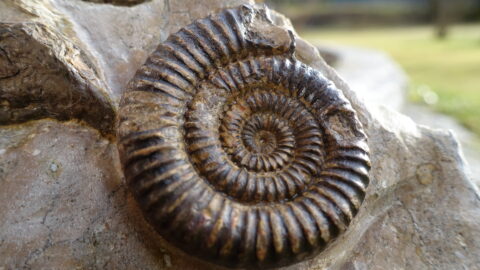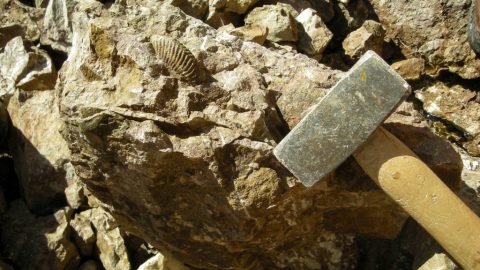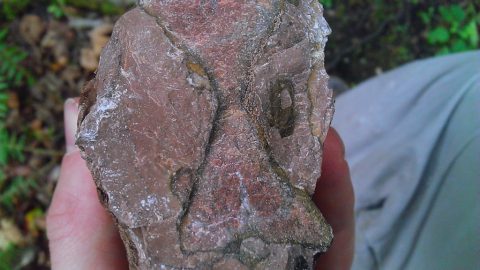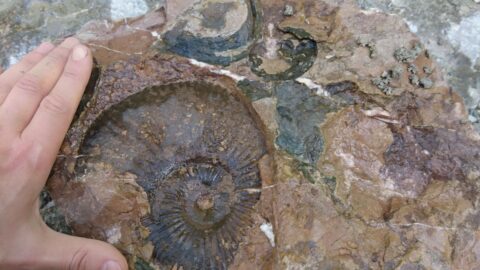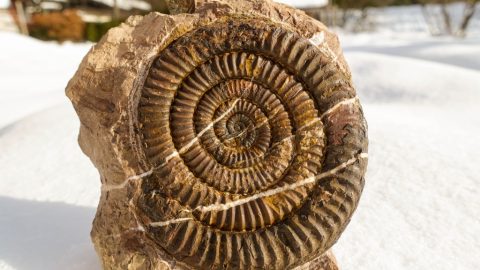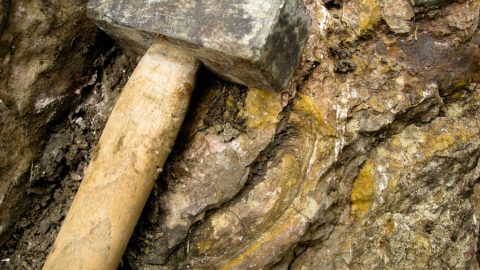Im Oktober 2010 war ich wegen der niedrigen Wasserstände im Gebirge und habe ein schönes Profil an der Trias / Jura Grenze vermessen. Dort bekommt man ansonsten die meiste Zeit im Jahr nur nasse Füße :).
Anschließend habe ich noch die interessanten umliegenden Horizonte angeklopft, allerdings ohne richtigen Erfolg.
Da noch Zeit war und die Sonne schien, habe ich mich kurz entschlossen aufgerafft und bin in das Bett des Hauptflusslaufes des Karwendeltals, der ebenfalls sehr wenig Wasser führte, eingestiegen. Dort landen alle Steine der mir bekannten fossilreichen Profile. Von Zeit zu Zeit „spuckt“ dieser deswegen mit viel Glück auch etwas Interessantes aus.
Bisher waren ab und an gute Funde in der Nähe der Mündungen der Seitenbäche möglich, meistens in Form von größeren Brocken. Die Häufigkeit nimmt bachabwärts dann schnell ab und die Steine werden immer kleiner (beim Transport zerstört).
Die erwarteten Brocken konnte ich aber leider nicht entdecken. So entfernte ich mich immer weiter von den verheißungsvollen Mündungen und spazierte über Kiesbänke und durch den Bach selbst.
Kurz vor Ende der letzten Kiesbank, mit bereits durchnässten Schuhen, dann die Überraschung:
Ein kleiner Brocken des ockerfarbenen Kalks der Schnöll-Formation spitzte zwischen den grauen Bachkugeln hervor, ca. 40 x 40 x 10cm.
Ich hebelte ihn heraus und ein paar kleine Querschnitte von Ammoniten wurden sichtbar. Dieses Gestein ist immer voll davon. Also dann: ich investierte einen Probeschlag parallel zur Schichtung.
Ein 8 cm großer Psiloceras naumanni NEUMAYR fiel mir entgegen! So ein Stück an einem so abgelegenen Platz zu finden ist schon bemerkenswert.
Der Rest-Stein wurde dann senkrecht zur Schichtung grob zerklopft.
Er zerbrach in drei Teile. Am größten Teil schaute eine Windung eines recht großen Ammoniten heraus! Ich vermutete ein weiteres Psiloceras naumanni und packte den ganzen Krempel zusammen. Zu groß ist die Gefahr, dass zu viel kaputt geht.
Zuhause sondierte ich dann dessen Erhaltung mit dem kleinen Spitzmeißelchen. Die Windung trennte gut und alles sah sehr viel versprechend aus.
Ein etwas gröberes Ansetzen des Meißels ließ plötzlich einen Spalt entstehen und der Deckel sprang weg:
Ein vollständig erhaltenes Exemplar eines Pleuracanthites polycycloides WAEHNER aus dem unteren Hettang! Durchmesser: 160mm!
Die Endpräparation war in wenigen Minuten erledigt.
Der Brocken ist weit gereist: 700 Höhenmeter nach unten gekugelt und ca. 1 km im Bachbett transportiert worden. Ein absoluter Zufall, dass der Ammonit vollständig eingebettet war! Und natürlich, dass er auch so selten ist.
Ein Zufall auch, dass er nicht sofort bei meiner zuerst groben Behandlung zerbrochen ist.
Der Frost und die Witterung haben ihn gut spaltbar gemacht. Die Schale ist bis zu den innersten Windungen erhalten. Ein solches Sammlungsstück habe ich bisher im Anstehenden noch nie gefunden!
Überraschungen gibt es immer wieder … wer hätte das gedacht?
In October 2010 I was in the Karwendel mountains because of the low water level of the streams and measured a nice profile at the Triassic / Jura border. Normally the only thing you can find there are wet feet :).
After that I knocked on the interesting horizons around it, but without real success.
Then there was still time and the sun was shining so I got up shortly and went into the bed of the main river of the Karwendel valley, which also had a very little water level. All the stones and rocks of the fossil-rich profiles end up in this stream. From time to time the stream „spits out“ some interesting stuff.
So far good finds were possible near the mouths of the side streams, mostly in the form of large chunks. The frequency decreases rapidly downstream and the stones become smaller and smaller (destroyed during transport).
But I could not discover any of the expected chunks there. So I moved more and more away from the promising side streams and walked over gravel banks and through the stream itself.
Shortly before the end of the last bank then the surprise, with already soaked shoes:
A small chunk of the ochre-colored limestone of the Schnöll formation peaked out between the gray stream balls, sized about 40 x 40 x 10cm.
I levered it out and a few small cross-sections of ammonites became visible. This rock is always full of them. So then I invested a test strike parallel to the stratification.
An 8 cm Psiloceras naumanni NEUMAYR fell towards me! To find a piece like this in such a remote place is quite remarkable.
The remaining stone was then roughly pounded perpendicular to the stratification.
It broke into three parts. At the largest part, a coil of a rather large ammonite peeked out! I suspected another Psiloceras naumanni and packed up all pieces. Too much risk of breaking too much.
At home, I then probed its preservation with the small pointed chisel. The twist separated well and everything looked very promising.
A slightly rougher application of the chisel suddenly caused a gap and the lid popped off:
It is a completely preserved specimen of a Pleuracanthites polycycloides WAEHNER from the lower Hettang! Diameter: 160mm!
The final preparation was done in a few minutes.
The chunk traveled a long way: rolled down 700 meters of altitude, transported about 1 km in the streambed. An absolute coincidence that the ammonite was completely embedded! And of course it is a very rare find as well.
A coincidence also that it did not break immediately during my first rough handling.
The frost and the weather have made it well cleavable. The shell is preserved up to the innermost convolutions. I have never found such a collection piece in the pending!
There are always surprises … who would have thought it?









